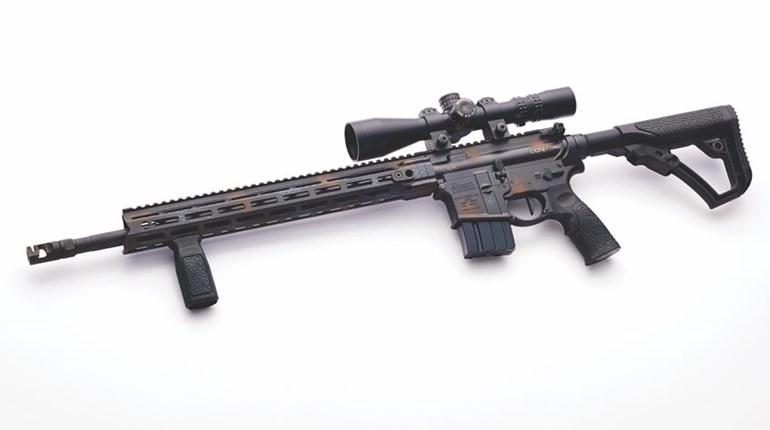
Readers have made some thoughtful inquiries the last couple of weeks, and we hope the replies have been useful. Certainly, they’ve added perspective to our considerations. Keep ’em coming: As always, we can’t get to each and every one, but we’ll roll queries up where it makes sense, and go from there.
This time out, we hope to forestall some questions with what is often an “Oh-oh” revelation, but framed in a question of our own: “What’s with the gathering of family members in apparent preference to ending the threat (Part 4)?”
One part of the answer is obvious: To make sure your loved ones—and especially those unable to meaningfully fend for themselves—can be protected. Whatever actions become necessary given the level of persistence and aggression you are facing, the well-being of these innocents is rightly your biggest concern.
… make sure your loved ones—and especially those unable to meaningfully fend for themselves—can be protected.An actual round-up has obvious difficulties. If you’re in the family room watching a movie together, or the backyard, say, enjoying a little badminton (or in our case, worseminton), it may be easy to get eyes on everybody. In circumstances like these, you are well positioned for a safe retreat.
Even if you reside in a castle doctrine and/or stand your ground state, remember that it is still preferable to cede “stuff,” however rotten it feels. Civil liability in the wake of a defensive firearm use practically gold plates this as wisdom, but there are other reasons too—not least your own conscience—why this should be option one.
But if family members aren’t within eye- or earshot, the importance of indoor and outdoor “rally points” emerge. At sight or sound of trouble, each member of the family needs to know what to do and where to head. This gets complicated in a hurry, and needs to be practiced.
A precursor is that everyone needs a buddy. This has many benefits, but the idea of “mutual support” is plainest and most versatile. A buddy system eases accounting for everyone, but also reinforces recollection and execution of your family’s plan. Keep in mind that a “fixed” buddy may be impractical. But getting with another family member if you’re in the same part of the house or property should be a priority unless the rally point is very close at hand.
An oft-forgotten advantage of a buddy strategy is how it can reduce the communication burden. The more emphatic and crucial the “comm” needs to be, the more important it is that the channel for the information not be overwhelmed. In other words, anything that keeps everyone in your family from yelling to each other in dismay is a good thing. If teamed, individual family members need less of the available bandwidth, and can keep communication information-rich rather than devolving into understandably raw apprehension, cacophony and dangerous uselessness.
In the simplest terms, we tend to think of visibly opaque surfaces as being impenetrable, but this is far from the truth.Cellphones probably ought to be a last resort because they create a situational awareness deficit, but they are nevertheless a potentially valuable fallback: If you’re separated and can safely use them, do so.
As a practical matter, though, coalescing to your rally points and giving ground may not always work. There are a host of reasons why anyone brazen enough to force their way into your home may see your separation, anxiety and confusion as an advantage, nullifying the “home ground” that normally helps the defender.
Physical separation brings another consideration into play, namely the construction and materials of your house. In the simplest terms, we tend to think of visibly opaque surfaces as being impenetrable, but this is far from the truth. This is why knowing the location of all your family members is such a big deal. If you’re forced into a situation where defensive shots are necessary, get it through your head that an errant one will probably not be stopped by most indoor materials.
We’d say it makes that “where are my loved ones?” part of the equation vastly more important. Keep in mind as well that what folks generally think are the lines of sight (and therefore of projectiles) through walls and floors are subjective and often startlingly inaccurate. A miss is a comparative disaster, and of course a danger to people outside the immediate area as well. (While external wall materials are generally tougher and thicker, they include highly permeable glass.)
As a whole, residential materials are not merely unreliable stoppers, but can redirect projectiles in unpredictable directions at still-dangerous velocities. Brick and stucco are sturdy exceptions in the case of most defensive ammunition types, but they’re usually on the wrong side of a miss. Other anecdotally-vetted barriers exist, but don’t really change the point: Don’t confuse “cover” with “concealment” around the house any more than you would in wider public spaces.
Brick and stucco are sturdy exceptions … but they’re usually on the wrong side of a miss.Our point, then, is a simple one: Knowing the whereabouts of family members is crucial because household materials afford little or no protection from shots by anyone—defender or aggressor. It is true you’ll have no control over interlopers, but the obligation to “know your target and what is beyond it” remains for you. Surely there is no need to amplify the rule in the case of your own loved ones.
All of which—we sincerely hope—is motivation along a familiar Carry Life axis: Train and practice, then practice and train. If you make us pick a crucial takeaway in the whole topic of home carry, it would be just that: Plan well enough that shooting is truly a last resort, and then know with precision where any shot is going.
If you don’t know, then don’t press—it’s that simple. Now Carry on.
Frank Winn has been studying arms and their relationship to tyranny, meaningful liberty and personal security all his adult life. He has been a firearms safety/shooting instructor for more than 20 years, and earned state, regional and national titles in several competitive disciplines.
































